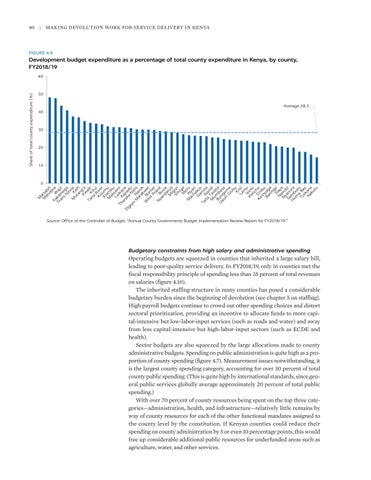80
|
Making Devolution Work for Service Delivery in Kenya
FIGURE 4.9
Development budget expenditure as a percentage of total county expenditure in Kenya, by county, FY2018/19
50 Average 28.5 40
30
20
10
0
M a M rsa an b de it Ka W ra k Tr a aj an m ir s eg Nz a o M K ia ur ili an fi Kwg'a al Ta e na Kit Ri ui Ki ve s r Ki um M ambu ak u La uen ik i Th ar Kaj ipia ak ia El ge a do Ni yo M Na thi ar ro ak k W B we es om t tP e o t Ny B kot an us da ia M rua ig Vi ori hi g M a e M N ru ac ye ha r i G ko ar s is Ta ita Na sa n T M av di o e Bu mb ta Ua n as sin go a m G a ish u K La isii m I u Ke siol ric o h Ki Em o rin b u Ba yag rin a g S o Na iay Ny iro a b Sa am i H mb ira om u a ru Tu Ba rk y Na an ku a ru
Share of total county expenditure (%)
60
Source: Office of the Controller of Budget, “Annual County Governments Budget Implementation Review Report for FY2018/19.”
Budgetary constraints from high salary and administrative spending
Operating budgets are squeezed in counties that inherited a large salary bill, leading to poor-quality service delivery. In FY2018/19, only 16 counties met the fiscal responsibility principle of spending less than 35 percent of total revenues on salaries (figure 4.10). The inherited staffing structure in many counties has posed a considerable budgetary burden since the beginning of devolution (see chapter 5 on staffing). High payroll budgets continue to crowd out other spending choices and distort sectoral prioritization, providing an incentive to allocate funds to more capital-intensive but low-labor-input services (such as roads and water) and away from less capital-intensive but high-labor-input sectors (such as ECDE and health). Sector budgets are also squeezed by the large allocations made to county administrative budgets. Spending on public administration is quite high as a proportion of county spending (figure 4.7). Measurement issues notwithstanding, it is the largest county spending category, accounting for over 30 percent of total county public spending. (This is quite high by international standards, since general public services globally average approximately 20 percent of total public spending.) With over 70 percent of county resources being spent on the top three categories—administration, health, and infrastructure—relatively little remains by way of county resources for each of the other functional mandates assigned to the county level by the constitution. If Kenyan counties could reduce their spending on county administration by 5 or even 10 percentage points, this would free up considerable additional public resources for underfunded areas such as agriculture, water, and other services.


